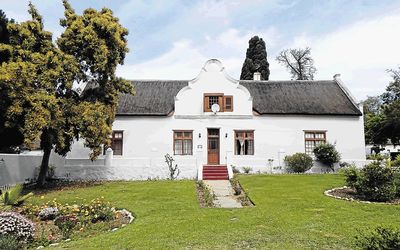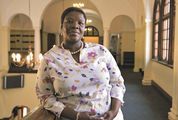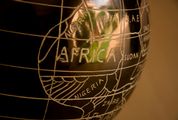ONCE upon a time, Cape Town had a problem with its meat. Because stock theft was threatening the city’s supply, Cape colony governor Willem Adriaan van der Stel had a group of soldiers set up a military post in 1701.
"This town was known as Groenekloof because it was so green and beautiful," says Ben Lottering, a retired reverend who joined the church in 1971. "But in 1854, they changed the name to Mamre, a biblical name from Genesis."
Lottering jokes that his sermons used to be so lengthy that people often fell asleep. And so, after our coffee and scones at Tori Oso Restaurant, the other fascinating tales come from town resident Stienie du Plessis, who takes us on a walking tour of the place.
"This little building has a big story," she says as we stand outside Die Bakhuisie that dates back to 1700. "They used it as a jail to lock up prisoners and also slaves. Later on, the first primary school was here. They used to cook for the kids and we still use it as a kitchen during church celebrations."
Indeed, the church plays a big role in the area. The Long House — with its six doors, six windows, and classic Cape Dutch gable in the centre — now acts as church office space, although it served as barracks for the garrison between 1701 and 1791.
"This is one of the buildings used in the Anglo-Boer War," du Plessis says. "At the back, you can still see the bullet holes, but we never got there because it’s fragile. The Parsonage (once a home for governor Simon van der Stel) was also used as a barracks for the sergeant in charge, but our head reverend stays here now. It’s the oldest building in Mamre and also a national monument."
The other national monument is the church. The building was completed in 1818, while the Moravian Church, which dates back to the 15th century, remains one of the oldest Protestant denominations in the world.
Things have come a long way since the first sermons in 1808 took place under poplar trees in Louwskloof at the base of the Dassenberg hills. In 1835, the town got an organ. And in 1872, it got a bell.
"It weighs around 250kg," du Plessis says, adding that two people take turns ringing it. "There are four angels and a leaf motif. And there are two inscriptions from the Bible: one from Luke 14:17 ("Come, for everything is now ready") and one from Psalms 100:4 ("Enter into His gates with thanksgiving and into His courts with praise")."
As we take our seats in the pews, du Plessis reflects on what services were like when she was growing up. Not only did men, women, girls, and boys sit in separate quadrants with a partition between them, but the reverend was also the principal of the school.
"He knew every child," she laughs. "If you weren’t in Sunday school, your name would be called out in the schoolyard on Monday. And if you weren’t in school and your parents didn’t send a letter, he’d send someone to look for you."
Part of that discipline is why the older generation knows so many of the church hymns. And the youngsters today? They don’t know because they don’t get taught these values in school.
"When we went to school, you had to learn everything," du Plessis says.
"And when you got confirmed, you had to know the whole thing out of your head. Now they get papers to read!"
But it’s hard to complain when their church is full every week, so much so that they have to fill the aisles with extra chairs.
"We have more than 45 church organisations: a brigade, choirs, bands, you name it," du Plessis says. "People come from all over to ask how we do it because people overseas don’t go to church anymore. They pay their church dues through the bank and their credit cards. And if you have five people in church, that’s a lot."
One of the benefits of having such a strong community is that they receive support for fundraising. It was the case when they had to spend R150,000 to fix the woodwork on the bell two years ago. Du Plessis hopes it will be the same when it’s time to fix the mill.
"They started off with a horse mill in 1830," she says. "And for all the farmers in the surrounding areas, this was the only place they could bring their wheat to be processed into flour."
In 1938, the town replaced the horse mill with a water mill, which they later replaced with steam and then diesel. But even though it stopped working in 1973, they hope to reopen the water channels. Indeed, despite the appearance that everything in Mamre is old, there’s development if you open your eyes.
"Can you believe that we had a gravel tennis court here first?" she asks as we stand outside Lobensaal.
"I used to play tennis when I was young. But they moved the court and built this hall here."
Although the town often used the Old School building (built in 1876) for events, it became too small. So they built the hall and named it in honour of Lottering.
"This whole area is a heritage site," Lottering says. "Nothing can be changed without permission." Then again, in a town untouched by time, this is one story that’s better left just the way it is.
The Mamre Heritage walk (part of the new West Coast Way Culture Route) is free, but all tips and donations go to upkeep

The Parsonage in Mamre was built in 1697 and was once a home for governor Simon van der Stel. It is part of the Mamre Heritage walk. Picture: EUGENE YIGA
ONCE upon a time, Cape Town had a problem with its meat. Because stock theft was threatening the city’s supply, Cape colony governor Willem Adriaan van der Stel had a group of soldiers set up a military post in 1701.
"This town was known as Groenekloof because it was so green and beautiful," says Ben Lottering, a retired reverend who joined the church in 1971. "But in 1854, they changed the name to Mamre, a biblical name from Genesis."
Lottering jokes that his sermons used to be so lengthy that people often fell asleep. And so, after our coffee and scones at Tori Oso Restaurant, the other fascinating tales come from town resident Stienie du Plessis, who takes us on a walking tour of the place.
"This little building has a big story," she says as we stand outside Die Bakhuisie that dates back to 1700. "They used it as a jail to lock up prisoners and also slaves. Later on, the first primary school was here. They used to cook for the kids and we still use it as a kitchen during church celebrations."
Indeed, the church plays a big role in the area. The Long House — with its six doors, six windows, and classic Cape Dutch gable in the centre — now acts as church office space, although it served as barracks for the garrison between 1701 and 1791.
"This is one of the buildings used in the Anglo-Boer War," du Plessis says. "At the back, you can still see the bullet holes, but we never got there because it’s fragile. The Parsonage (once a home for governor Simon van der Stel) was also used as a barracks for the sergeant in charge, but our head reverend stays here now. It’s the oldest building in Mamre and also a national monument."
The other national monument is the church. The building was completed in 1818, while the Moravian Church, which dates back to the 15th century, remains one of the oldest Protestant denominations in the world.
Things have come a long way since the first sermons in 1808 took place under poplar trees in Louwskloof at the base of the Dassenberg hills. In 1835, the town got an organ. And in 1872, it got a bell.
"It weighs around 250kg," du Plessis says, adding that two people take turns ringing it. "There are four angels and a leaf motif. And there are two inscriptions from the Bible: one from Luke 14:17 ("Come, for everything is now ready") and one from Psalms 100:4 ("Enter into His gates with thanksgiving and into His courts with praise")."
As we take our seats in the pews, du Plessis reflects on what services were like when she was growing up. Not only did men, women, girls, and boys sit in separate quadrants with a partition between them, but the reverend was also the principal of the school.
"He knew every child," she laughs. "If you weren’t in Sunday school, your name would be called out in the schoolyard on Monday. And if you weren’t in school and your parents didn’t send a letter, he’d send someone to look for you."
Part of that discipline is why the older generation knows so many of the church hymns. And the youngsters today? They don’t know because they don’t get taught these values in school.
"When we went to school, you had to learn everything," du Plessis says.
"And when you got confirmed, you had to know the whole thing out of your head. Now they get papers to read!"
But it’s hard to complain when their church is full every week, so much so that they have to fill the aisles with extra chairs.
"We have more than 45 church organisations: a brigade, choirs, bands, you name it," du Plessis says. "People come from all over to ask how we do it because people overseas don’t go to church anymore. They pay their church dues through the bank and their credit cards. And if you have five people in church, that’s a lot."
One of the benefits of having such a strong community is that they receive support for fundraising. It was the case when they had to spend R150,000 to fix the woodwork on the bell two years ago. Du Plessis hopes it will be the same when it’s time to fix the mill.
"They started off with a horse mill in 1830," she says. "And for all the farmers in the surrounding areas, this was the only place they could bring their wheat to be processed into flour."
In 1938, the town replaced the horse mill with a water mill, which they later replaced with steam and then diesel. But even though it stopped working in 1973, they hope to reopen the water channels. Indeed, despite the appearance that everything in Mamre is old, there’s development if you open your eyes.
"Can you believe that we had a gravel tennis court here first?" she asks as we stand outside Lobensaal.
"I used to play tennis when I was young. But they moved the court and built this hall here."
Although the town often used the Old School building (built in 1876) for events, it became too small. So they built the hall and named it in honour of Lottering.
"This whole area is a heritage site," Lottering says. "Nothing can be changed without permission." Then again, in a town untouched by time, this is one story that’s better left just the way it is.
The Mamre Heritage walk (part of the new West Coast Way Culture Route) is free, but all tips and donations go to upkeep




















Change: 0.83%
Change: 0.93%
Change: 0.95%
Change: 0.73%
Change: 1.91%
Data supplied by Profile Data
Change: 0.58%
Change: 0.39%
Change: 0.83%
Change: 0.00%
Change: 0.50%
Data supplied by Profile Data
Change: -1.48%
Change: -0.86%
Change: -0.53%
Change: -1.00%
Change: -0.35%
Data supplied by Profile Data
Change: 2.30%
Change: 2.09%
Change: 2.23%
Change: 2.82%
Change: 3.62%
Data supplied by Profile Data